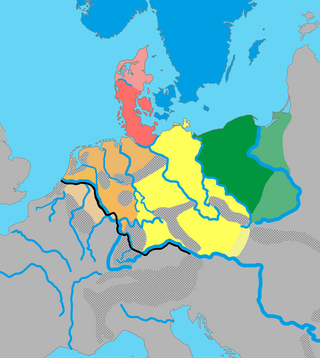Top Qs
Timeline
Chat
Perspective
Weser–Rhine Germanic
Language group From Wikipedia, the free encyclopedia
Remove ads
Weser–Rhine Germanic languages (or Rhine–Weser Germanic, German: Rheinweser-germanisch), sometimes also referred to as Istvaeonic languages, are a proposed Frank-related subgroup of the West Germanic languages which would in terms of modern languages unite both West Central German dialects and Low Franconian dialects including standard Dutch.
According to original versions of this proposal, introduced by the German linguist Friedrich Maurer (1898-1984), this subgroup descends from a distinct Frankish language, while the related ancestral languages of the so called Elbe Germanic dialects to the south, and North Sea Germanic languages to the north, only subsequently became smoothly connected within the same dialect continuum.
Maurer's proposals were influenced not only by linguistic evidence, but also by the Germanic archaeological provinces defined by Raphael von Uslar in 1938, which include the so called Rhine-Weser Germanic peoples, and by early Roman era reports of the Istvaeones – a group of Germanic peoples which lived near the River Rhine, and understood themselve to share a distinct common ancestry, according to their descriptions by Tacitus and Pliny the Elder.[1][2]
Maurer's original version of this concept involved the rejection of the common linguistic proposal that there was a single Roman era West Germanic proto language and believed that although the ancestors of the Franks received their Germanic languages from the Elbe region to their east, which was also the source of the southern German dialects, their language was originally distinct, and influenced by an older substrate language which was possibly Celtic.[3]
Remove ads
Nomenclature
Summarize
Perspective
The English term "Weser-Rhine" is used as an equivalent to the German term weser-rheingermanisch which was introduced into linguistics by Maurer, or rhein-wesergermanisch, which is influenced by the term now more commonly used by more German archaeologists. "Rhine-Weser" is also sometimes used in English.[4] Maurer's term was influenced by the archaeological findings of Raphael von Uslar in 1938, although in the field of archaeology itself Gerhard Mildenburger had already introduced the term rhein-wesergermanisch to refer to what Uslar himself had originally simply called the inland part of the "West Germanic area in the narrower sense".[5][6] This regionalisation is still commonly used in archaeology, where it is considered convenient, although the idea that it represents a clearly defined cultural area is no longer widely accepted.[7] The maps of Uslar visualized the area being roughly between the Rhine and Weser rivers in what is now Western Germany, stretching north the upper Ems and south to the Main.[8]
The term "Istvaeonic language" (German Istväonisch, Istvaeonisch or Istwäonisch) was part of a tripartite distinction given in Roman sources, which had already being used in linguistics before Maurer. The Istvaeones (or Istaevones) were a group of Germanic peoples mentioned by two Roman authors in the first century AD. Pliny the Elder (c. 23-79 AD) described them in his Natural History as one of five major groupings of Germanic peoples, who lived near the Rhine, and were distinct from the Ingvaeones on the North Sea coast, and the Herminones who lived further inland from the Ingvaeones and Istvaeones. (The other two groups, the Vandili and Peucini, lived east of the Elbe river.)[2] Tacitus (c. 56-120 AD) in his Germania added that these three western groups claimed, on the authority of ancient songs (carmina antiqua), to descend from three sons of a common ancestor named Mannus, who was in turn the son of a god.[1]
Remove ads
Theory
In the influential scheme of Maurer the original Weser-Rhine Germanic was ancestral to a proposed early Frankish language, and related dialects in Hesse. This was before the High German consonant shift, and so this language was ancestral to both Low Franconian language such as modern Dutch, and West Central German Franconian dialects which all underwent at least part of the consonant shift.[9][10] This language family effectively joined into the greater West Germanic language continuum, from which the consonant shifts spread. It was proposed that this unification of the languages was encouraged by the political unification of these areas achieved by the Merovingian dynasty.
Linguistic evidence indicates that Weser–Rhine Germanic was transitional between Elbe Germanic and North Sea Germanic, but it had a few innovations of its own.[11]
Remove ads
Maurer's methodology

Maurer's approach of drawing linguistic conclusions from non-linguistic evidence was influenced by Gustav Kossinna. He proposed that the Germanic dialects which eventually entered the Rhine-Weser region became a distinct group of dialects spoken by the Franks and Chatti around the northwestern banks of the Rhine, who were presumed to be descendants of the earlier Istvaeones.[3]
Maurer asserted that the cladistic tree model, ubiquitously used in 19th and early 20th century linguistics, was too inaccurate to describe the relation between the modern Germanic languages, especially those belonging to its Western branch. Rather than depicting Old English, Old Dutch, Old Saxon, Old Frisian and Old High German as having simply 'branched off' from a single common 'Proto-West Germanic', he proposed that there had been much more distance between the languages and the dialects of the Germanic regions.[12]
References
Sources
See also
Wikiwand - on
Seamless Wikipedia browsing. On steroids.
Remove ads

